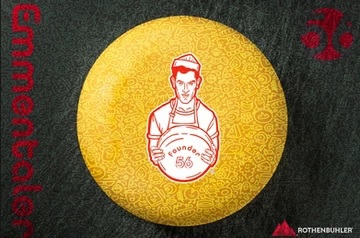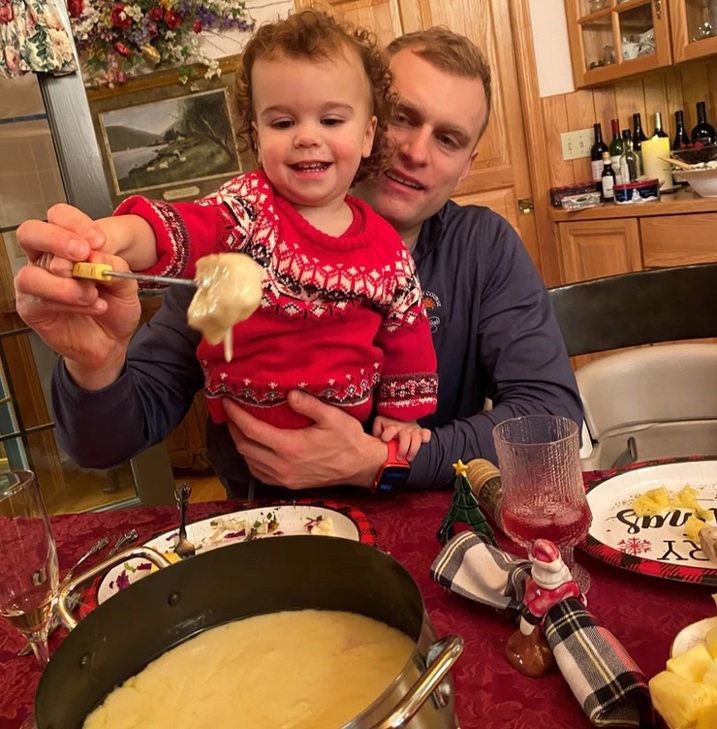Which Cheese Makes The Best Fondue? Grandpa Hans Knew Best.
Who doesn’t love fondue? I would say only unfun people. The hot & gooey cheese delight that originated in 18th century Switzerland has grown into one of the most beloved sharing dishes in the world.
My Grandfather Hans, who was the epitome of fun and the founder of Rothenbühler Cheesemakers, was a big fondue fan. One of my fondest childhood memories was making fondue with Grandpa Hans at Thanksgiving and Christmas.
Over the years, many people in my family have wanted to know the secret to Grandpa’s Swiss Cheese fondue. I tell that, while there were several rules he followed, he always insisted first and foremost that the perfect fondue starts with the perfect cheese. And, he took great pride in pointing out that it was his very own Rothenbüher cheeses that made his recipe special.
Here are Grandpa Han’s rules for selecting the perfect cheese and making the best, most authentic Swiss cheese fondue.
Rule #1: The Older The Better
For truly authentic Swiss fondue, Grandpa Hans insisted on a well aged Alpine cheese - semi hard cheese made from cow’s milk. And, while many people suggest that Gruyere or Emmentaler are the best cheeses for fondue, Grandpa Hans always said the most important thing was to start with a cheese that has aged for 1 year or more. Aged cheese makes for better fondue because during the aging process, special enzymes develop that break down proteins that allow the cheese to melt more easily, provide a smoother texture and help keep the fat from separating once
 melted.The worst thing that can happen to fondue is that it becomes lumpy or stringy.
melted.The worst thing that can happen to fondue is that it becomes lumpy or stringy.
And, like fine wine, the taste of the cheese gets better with age. The flavor becomes fuller with a sharper and extra nutty taste. This is why Grandpa Han’s always started with his very special Rothenbühler Reserve Aged Swiss. Grandpa was super proud of this award-winning cheese and he made sure it was the centerpiece of his Holiday Fondue.
Rule #2: The Bolder The Better
As you’ve probably guessed by now, Grandpa Hans was a larger than life character who never shied away from bold flavor. That’s why his second rule of fondue was to go big or go home on flavor. Grandpa Hans always amplified his already flavorful Reserve Aged Swiss with his robust flavored Ursario Swiss. This was another one of his intensely flavored favorites that added a layer of sweet cashew notes into the mix. He always said that Ursario reminded him of old world Swiss cheese flavors found in the Emmental valley – Han’s birthplace and the birthplace of Swiss cheese.
Rule #3: The Right Wine Makes A Difference
Like many old world culinary craftsmen, Han’s always said that the right wine makes a big difference in the fondue. This is why his third rule was to always add a little dry white wine to the pot. Of course a German or Swiss Riesling was always his preference.
But, keep in mind that it’s not about the alcohol in the wine, it's about the acid. As with the aged Swiss, the acid helps keep the fondue from splitting (i.e. the fat separating from the cheese). You could also use a stout or lager beer instead of wine. If you want to avoid wine and beer, you can simply add some lemon juice to provide the acid you need.
Rule #4: A little Kirsch never hurts
Kirsch (also called Kirschwasser) is a dry, clear brandy distilled from the fermented juice of the black morello cherry. Kirsch is made in the Black Forest of Germany and in the German-speaking areas of Switzerland. Traditional Swiss fondue calls for the addition of Kirsch into the pot. Grandpa’s fourth rule was to never forget the Kirsch. Yes, it adds a little brandy flavor and yes it helps ensure the fondue stays creamy. But it is also part of tradition. It’s not Swiss fondue without the Kirsch.
Side Note: Grandpa also enjoyed a little sip of Kirsch here and there while making the fondue. It was sort of a celebration of his fondue achievement. You might enjoy this too.
Rule #5: The Right Dippers Add The Fun
Swiss tradition calls for bite sized bread pieces, cured meats and dried fruit. But Grandpa Han’s would always include some vegetable pieces, steamed potatoes and one or two surprise options to entertain the kids. Grandpa’s fifth rule was to always add a little dipping fun into the mix. As I think back to those Holiday fondue meals, I always remember a smorgasbord of dipping options. Choosing from the assortment was half the fun. Here is a list of the classic Rothenbühler family favorites:
Bread: Dried or “day-old” French bread pieces are the classic dipper. Not too hard, but hard enough so they stay firm when dipped.
Meat: This may be obvious, but never use raw meat. The fondue pot is never hot enough to cook meat. Pre cooked Swiss or German sausages are great choices. If you can find it, Cervelat is a classic Swiss sausage.
Fruit: Apples slices are another classic choice. Dried fruits like dates, apricots and figs are also great options.
Potato: Steamed red potatoes cut into bite-sized chunks are a hearty addition to any fondue offering. Sometimes Grandpa Hans would find and use small German Butterball potatoes.
Veggies: Cherry tomatoes broccoli, cauliflower, carrots or bell pepper slices work great. Are pickles veggies? Yes, they are! As a kid, this was my favorite dipper.

Rule #6: The Right Pot Sets The Foundation
One of the fundamental details that Grandpa Hans always fussed about was the pot. He was adamant that great fondue starts with the pot (though, this may be more about Grandpa’s stubbornness rather than the fondue). His sixth rule was that a bigger and thicker pot was always better.
His reasoning was that it’s important to heat the pot evenly and melt the cheese slowly while stirring constantly. A big and sturdy pot helped make this happen. That being said, you can always transfer the fondue into a serving pot designed to keep the fondue warm and that might look a little more special on the table.
Rule #7: Never Rush It
Grandpa's seventh and final rule was that fondue cannot be rushed. On the occasions that I would help him, he always had me add the cheese to the pot in stages. Dumping it all in at once, he would say, won’t allow the cheese to melt right. If we were pressed for time, he would have me grate the cheese before putting it into the pot to help it melt a little faster and more evenly.
One word of caution; never use pre-shredded cheese because it has been coated with a compound that keeps it from clumping that will seriously screw up the fondue texture and appearance. I learned this the hard way.
Rothenbühler Family Fondue Recipe
If you would like, you can try Grandpa Han’s famous fondue for yourself. We would be happy to sell and send you our Reserve Aged Swiss or Ursario Robust Swiss to use. Or, if you are in the Cleveland area you can pick some up at our Cheese Chalet in Middlefield.
FONDUE INGREDIENTS
- 1 lb. Reserve, shredded
- ½ lb. Ursario, shredded
- 2 cups buttermilk
- 1 garlic clove
- 1¼ cups dry white wine
- 3 Tbsp. cornstarch
- 3 small whisky glasses of kirsch
- Ground white pepper
- ¼ tsp. ground nutmeg
DIRECTIONS
-
Rub a heavy stainless steel saucepan or heat proof clay fondue pot with split garlic clove.
-
Dissolve the cornstarch in the kirsch.
-
Put the cheese and wine into the pan and slowly bring to a boil, stirring constantly.
-
When the cheese is completely melted, add the kirsch and cornstarch mixture, stirring vigorously.
-
Continue to cook.
-
Season with white pepper and ground nutmeg.
-
Serve over an alcohol lamp. The cooking should continue on low heat.
-
Stir continuously
Grandpa Hans never used a thermometer. He just instinctively knew the right amount of heat to apply. As for me, a good thermometer helps make sure my fondue stays at the perfect 130 degrees.